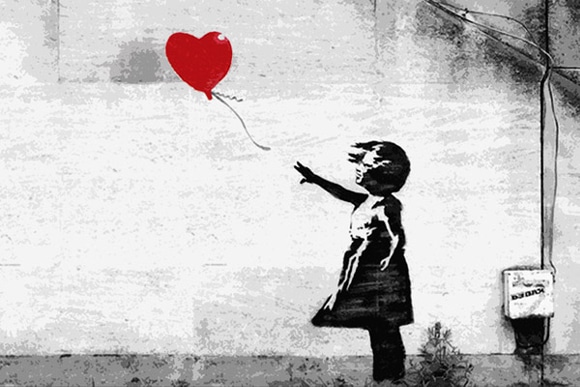
Source: Banksy
On December 31st, 2017, I became a statistic.
I joined the 60% of donors who become former donors to the charities they had been supporting.
I was the textbook definition of a below the radar donor with potential. I had loyally supported a few smaller to mid-size nonprofits at a self-selected mid-level giving range for more than seven years. I believe in the missions of these organizations and wanted to contribute a meaningful annual gift. Over that time, I chose without being asked to increase my giving for a wide range of reasons. But from time to time my giving fluctuated. When the year-end solicitations arrived in my mailbox I sometimes couldn’t remember what my last gift had been or readjusted my giving level based on whatever number fit into my philanthropic plans at that time.
Truth be told, sometimes I drastically changed my gift amount to see if the nonprofits would notice. Guess what? They didn’t. They never noticed, even after their Development Director or Executive Director took the time to write a personal note at the bottom of my acknowledgement letter. Clearly these organizations weren’t looking below the surface to see how their donors were tracking overall. Worse still, they never noticed how long I had been giving to them (i.e. my lifetime value). They never personalized their correspondence with me to say “hey, we noticed you haven’t made your gift yet this year…” or “wow, you’ve been supporting us since…” I mean, even American Express points out how long I’ve been a cardholder when I call customer service. And you know what? It makes me feel good that they are paying attention.
As 2017 came to a close and I made year-end giving decisions, I readjusted my philanthropy to include a couple new organizations with whom I had become involved as a volunteer. It meant some gifts had to be reallocated.
The nonprofits I remain committed to are the ones who truly value me as a donor. Who send me personal updates. Who ask my opinion or advice. Who show me how I am making a difference. Who genuinely appreciate me for the decision to support them.
What’s the moral of this story? Don’t become complacent.
Donors don’t stop giving. They just stop giving to you. It’s easy to fall into the trap of thinking that just because donors have chosen to invest in our cause, they will unconditionally support us and will give again when we ask. As you see from my personal story, the organizations who went even an extra inch to see me as more than an annual gift are the ones who make me feel like I’m making a difference in their work. They are the ones I continue to support.
Fundraisers must always consider the person—not the check—on the other side of the table. Now, I get that this is impossible to do with a small staff and a large numbers of annual donors. But there is a subset of donors you should be paying attention to. What’s driving that donor to give or to stop giving? Do you inspire your donor’s emotional connection to your mission through your communications? Do you celebrate your donors as partners in all of the ways you intersect with them?
Good donor engagement involves a regular calendar of touchpoints, updates, and communications that highlights stories of successes, progress, results, and even failures and challenges. Notice “solicitations” isn’t included in this list. Fifty percent of respondents in the 2014 Burk Donor Survey, cited over-solicitation—whether real or perceived—as a top reason for no longer giving to charities. Donors want to see, feel, and experience the impact their gifts are having so they can feel reassured that continued support will still make a difference. There are many multi-channel ways to bring your work to life for your donors such as through social media, videos, virtual reality, personal letters, emails, or phone calls from your beneficiaries, and even personal site visits to see your work.
We know that the average retention rate is about 45%. For nonprofits with limited staff and resources, chasing donor churn is neither profitable nor sustainable in the long-run.
And that’s why:
Relationships Matter. As a fundraiser and a donor, I can attest to the fact that giving is more than writing a check. It’s my small way to affect the change I want in the world. The nonprofits that take the time to keep me regularly informed, know about my giving patterns and longevity, and genuinely show that I matter as a donor and/or volunteer make me feel that this isn’t a transaction.
As human beings, we are hard-wired for connection. Our brains are literally designed to form bonds and seek families—biological or synthetic. So why aren’t we tapping into this actionable knowledge in the fundraising sector?
There’s no shortage of research pointing the way. Behavioral psychologists have uncovered significant insights into how our brains respond to philanthropy and volunteerism. For example, one study shows a correlation between an individual’s charitable giving behaviors and their level of happiness. The act of making a gift or volunteering literally triggers the oxytocin-rich social attachment regions in our brains. So, making a gift creates a bond with the organization we are supporting because our minds equate the act of donating with relationship building.
Are you focused on building relationships or collecting checks? Believe me, your donors will notice the difference.
